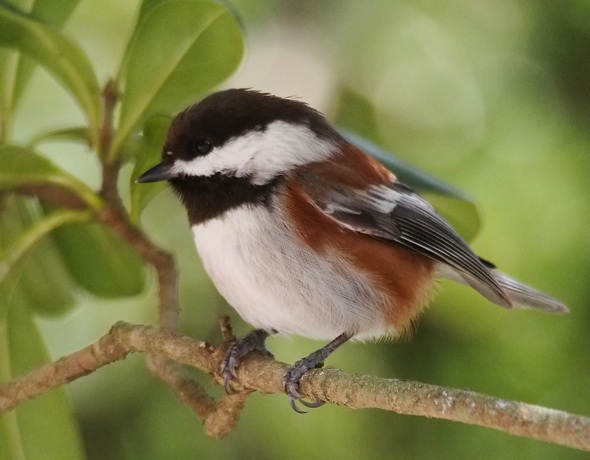A practical guide to bird watching in Sonoma County, California
(Unless otherwise indicated, all phone numbers are in the 707 area code)
A practical guide to bird watching in Sonoma County, California
(Unless otherwise indicated, all phone numbers are in the 707 area code)


Fairly common in wooded areas throughout the county, including residential areas, but mostly stays in the more humid coastal forests rather than the drier country inland where this bird is confined to canyon bottoms and other pockets of favorable habitat. Common feeder visitor in suburbia. Often travels in small flocks, sometimes in mixed flocks of other full-time residents (Oak Titmouse, Bushtit, vireos, and nuthatches) and with warblers during migration. Looking for chickadee flocks is, in fact, a well-known strategy for finding unusual warblers in the spring and autumn. Nests in naturally existing cavities or abandoned woodpecker holes. Also uses net boxes. Can be quite acrobatic, feeding while hanging upside down or sideways, exploiting resources overlooked by other common woodland birds. Mostly eats insects but will eat seeds and berries. Fond of suet as well. Sometimes quite tame near parks or feeders. Older sources will list this bird as Parus rufescens. Often noisy, especially when in flocks. Says shik-a-jee-jee in a high, thin voice compared with Oak Titmouse, which makes similar sounds but in a somewhat louder, lower-pitched, huskier voice.
The only chickadee regularly present in Sonoma County. Distinguished from other chickadees by its rufous back and sides, although subspecies to the south of us have comparatively little of the chestnut color on their sides. Three subspecies are recognized. Poecile rufescens rufescens, found from Alaska south to northwestern California and east to Montana, has the most obvious rufous on the flanks (like the bird above). P.r. neglectus, with narrow, pale rufous bands on the flanks, is confined to southern Marin County. (This subspecies may have been lost to interbreeding with P. r. rufescens populations that have moved south from Sonoma County comparatively recently, according to Lukas.) P. r. barlowi, found in coastal southern California (from San Francisco south), has very little rufous on the flanks at all. The bird in the photo below was photographed in Sonoma County (Santa Rosa) but it is plain grey on the flanks. This may also be P. r. barlowi. It is in any case atypical for the county. Our birds are mostly of the P. r. rufescens subspecies, with unambiguously chestnut sides, as in the main photo above.
Further reading:
Bolander and Parmeter, Birds of Sonoma County California, rev. ed., 2000, p. 91
Brinkley, National Wildlife Federation Field Guide to Birds of North America, 2007, p. 341
Burridge, ed., Sonoma County Breeding Bird Atlas, 1995, p. 116
Dunn and Alderfer, eds., National Geographic Field Guide to the Birds of North America, 5th ed., 2006, p. 338
Dunn and Alderfer, eds., National Geographic Field Guide to the Birds of North America, 6th ed., 2011, p. 378
Ehrlich, Dobkin, and Wheye, The Birder's Handbook, paperback edition, 1988, p. 428
Fix and Bezener, Birds of Northern California, 2000, p. 278
Floyd, Smithsonian Field Guide to the Birds of North America, 2008, p. 333
Kaufman, Field Guide to Birds of North America, 2000, p. 282
Kaufman, Advanced Birding, 1990, pp. 217-219
Lukas, Bay Area Birds: From Sonoma County to Monterey Bay, 2012, p. 187, 204-205, 225
Parmeter and Wight, Birds of Sonoma County California, Update (2000-2010), 2012, p. 54
Peterson, Field Guide to Birds of Western North America, 4th ed., 2010, p. 274
Peterson, Western Birds, 3rd ed., 1990, p. 258
Sibley, Field Guide to Birds of Western North America,1st ed., 2003, p. 321
Stokes, Stokes Field Guide to the Birds of North America, 1st ed., 2010, p. 525
Vuilleumier, American Museum of Natural History, Birds of North America: Western Region, 2011, p. 287
Voice: Cornell Lab of Ornithology: All About Birds--Chestnut-backed Chickadee
© Colin Talcroft, 2009, 2010, 2011, 2012, 2013, 2014, 2015, 2016
Unless noted, all photos by the author. If you would like to use one of my images, please ask for permission for non-commercial use with proper credit or commercial use with proper compensation.

For comparison: Mountain Chickadee (Poecile gambeli)--Note lack of chestnut and the broken black cap, giving a masked look. Not usually present in Sonoma County, but found at higher elevations in nearby counties.

Chestnut-backed Chickadee. This bird is uncharacteristically plain on the sides for a Sonoma County bird
Lake Ralphine, Santa Rosa, September 11, 2012
Chestnut-backed Chickadee, showing the typical rufous back and sides of Sonoma County birds
Spring Lake, January 17, 2013

Chestnut-backed Chickadee
Poecile rufescens
EBird reported occurrence in Sonoma County
1990-2013 Sonoma County data. Graph provided by eBird (www.ebird.org), generated May 30, 2013




Chestnut-backed Chickadee, Sebastopol, December 27, 2015